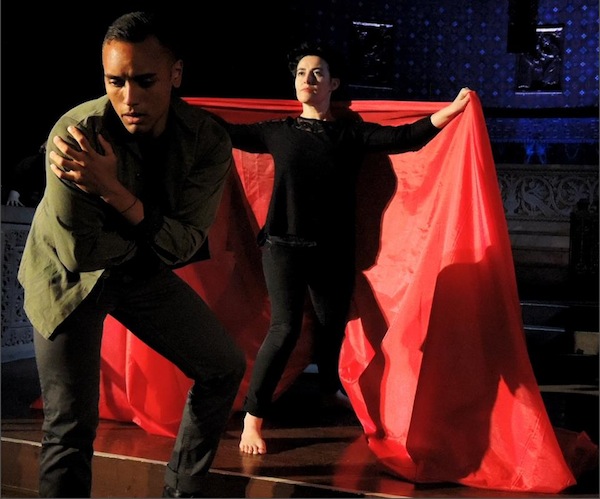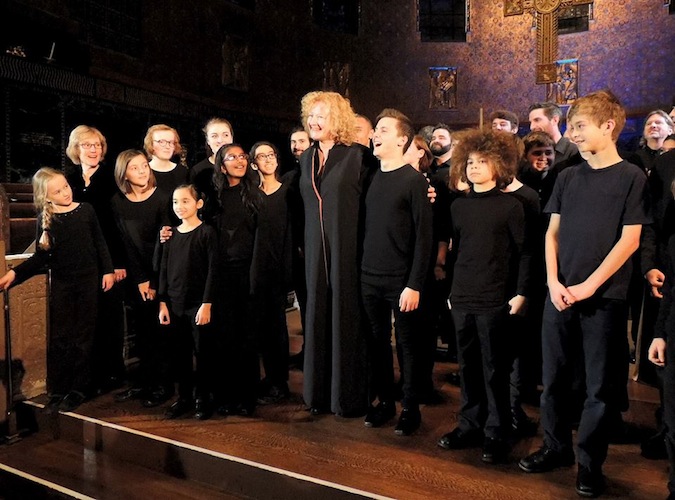Concert Review: “The Play of Daniel” — The Boston Camerata’s Production is One for the Ages
The Boston Camerata’s imaginative staging of The Play of Daniel generated plenty of “serious fun.”

Daniel (Jordan Weatherston Pitts) protected by an angel (Jane Sheldon) in the lion’s den in Boston Camerata’s “The Play of Daniel.” Photo: Joel Cohen.
By Susan Miron
Under Anne Azéma, its French-born music and stage director, scholar, and singer, The Boston Camerata staged an extraordinary performance of The Play of Daniel at Boston’s Trinity Church on Friday night (and Sunday afternoon). It will undoubtedly be one of the highlights of the 2014 classical music season in Boston.
Now in their sixtieth season, The Camerata last staged this medieval musical theater piece in 1983, when ideas about how to perform medieval music were quite different than they are today. “Ludus Daniellis,” or The Play of Daniel, was composed eight centuries ago (around 1230) in Beauvais in northern France. The work was made to be staged by the church’s subdeacons, who existed at the lowest end of its hierarchy. Azéma said before the Camerata performance that the goal was to create a vehicle that would allow them to “blow off a little steam after the intensity of the Christmas season.” It was composed for the Feast of the Circumcision, a time of church-sanctioned raucous revelry.
The Hebrew Bible (in Writings/Ketuvim) and Christian Bible (in Major Prophets) have joint custody of the story of Daniel. Celebrated for his ability to foresee the future (especially his interpretation of the prophetic ‘Writing on the Wall’), Daniel ends up in the lion’s den. This is a narrative of resistance to despotism that has understandably proved to be perennially engrossing, despite (or because of) its fairy tale resonances. In the words of Azéma, Daniel, a Jewish captive in Babylon, is “the accuser of tyrants, the scourge of their vanity, and the foreteller of their downfall…. (whose) narrative of the triumph of the enslaved over the powerful creates an eternal metaphor and beacon of hope.”
The play recounts two episodes from Daniel: Belshazzar’s feast and Daniel’s ordeal in the lions’ den, both sung and spoken in Latin and early-medieval French. The Play of Daniel was first – and famously – produced in America in 1958 at the Cloisters by Noah Greenberg and his New York Pro Musica Antiqua ensemble. This staging (produced by Lincoln Kirstein with an English-language narration by W.H. Auden) helped spark the the Early Music movement, especially in New York. (The piece was just performed last year at the Rockport Chamber Music Festival under Mary Ann Ballard.) There is obviously a great deal of interpretative leeway when it comes to the reconstruction of the work: scholars passionately dissect each performance, speculating on how The Play of Daniel should be performed, if and which instruments should be used, and so on. This give-and-take is accepted practice: new performances of medieval work vary greatly, especially in terms of the use of instruments.
A short synopsis: King Belshazzar presides over the captivity of the Jews in Babylon. Imprisoned at his court, Daniel sees mysterious writing on the wall and interprets it as foreshadowing the king’s overthrow. The Persian ruler Darius soon deposes Belshazzar and tosses Daniel thrown into the lions’ den. The endangered prophet is released by an angel, whereupon he declares the coming birth of Jesus. The latter, of course, sheds an unmistakable Christian cast on a book contained in the Hebrew Bible.
The superb (and ubiquitous) early music tenor Jason McStoots was cast as the corrupt King Belshazzar, who sported a dashing red fez. The astonishingly talented dancer Indrany Datta-Barau (who is also a working psychiatrist), all but stole the show with her riveting performance, which strongly suggested the decadence in Belshazzar’s court. Joel Fredricksen’s penetrating and beautiful bass voice made him a memorably sun-glass-clad Darius. Two gifted instrumentalists, viellist/medieval harpist Shira Kammen and percussionist Karim Nagi, contributed considerably to the production’s beauty and appeal. Azéma sang with the choirs, narrated, and played hurdy-gurdy. The angelic voices included students from Longy School’s Early Music Department, and child singers from the Boston City Singers and the Trinity Choristers.

Anne Azéma and cast taking a curtain call at the end of “The Play of Daniel.” Photo: Joel Cohen.
In the words of Azéma, the Camerata production was about providing plenty of “serious fun.” And it did: lots of incense, memorable dancing, a large cast of singers who were also good actors, two choruses of youngsters, plenty of theater, liturgy, and the clever use of the gorgeous Trinity Church for processionals, recessionals, and singing from the balcony.
The production was a also feast for the senses. There was the incense (not often found in the air at concerts!), the fabulous dancing, Peter Torpey’s dramatic lighting, and the beauty of the Gregorian chants which prefaced “Daniel,” drawn from the same manuscript. Most of the cast wore black pants and shirts, although Daniel donned khaki. There was not a dull moment, nor one without beauty or drama.
The stand-out in this production of excellent and seasoned singers was the gifted young performer Jordan Wetherston Pitts, whose Daniel was a part he was born to take on. If this production wanted New York-style hype, it might have proclaimed of his spellbinding prophet, “Jordan Wetherston Pitts IS Daniel.”
As for the “authenticity” issue in musical reconstruction, Joel Cohen reminds us that “we are centuries away from any living performance tradition for these works … as with all medieval music we seek to perform anew, the recreation of some sort of plausible playing and singing ethos is a paramount consideration.” Precise historical accuracy, Azéma explained, is “a puff of smoke. None of us were there. So we can make enlightened choices based on the best knowledge we can gather about what was happening. And then we need to go out and perform.” Her choices led to feats of imagination that were tasteful, inspiring, and witty, making this Play of Daniel one for the ages.
Susan Miron, a harpist, has been a book reviewer for over 20 years for a large variety of literary publications and newspapers. Her fields of expertise were East and Central European, Irish, and Israeli literature. Susan covers classical music for The Arts Fuse and The Boston Musical Intelligencer. She is part of the Celtic harp and storytelling duo A Bard’s Feast with renowned storyteller Norah Dooley and, until recently, played the Celtic harp at the Cancer Center at Newton Wellesley Hospital.
Tagged: Anne Azéma, Indrany Datta-Barau, Jason McStoots, The Boston Camerata
